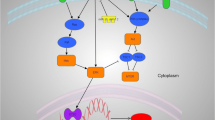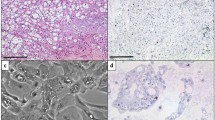Abstract
Chordomas are malignant neoplasms that typically arise in the axial spine and primarily affect adults. When chordomas arise in pediatric patients they are more likely to display unusual histological features and aggressive behavior. We noted the absence of SMARCB1/INI1 expression by immunohistochemistry in an index case of poorly differentiated chordoma of the sacrum, leading us to further examine SMARCB1/INI1 expression as well as that of brachyury, a highly specific marker of notochordal differentiation, in 3 additional poorly differentiated chordomas of the clivus, 10 typical chordomas, and 8 atypical teratoid/rhabdoid tumors (AT/RTs). All 4 poorly differentiated chordomas and all AT/RTs lacked nuclear expression of SMARCB1/INI1, while the 10 typical chordomas maintained strong nuclear SMARCB1/INI1 immunoreactivity. All 10 typical and 4 poorly differentiated chordomas expressed brachyury; all 8 AT/RTs were brachyury immunonegative. Cytogenetic evaluation utilizing FISH probes near the SMARCB1/INI1 locus on chromosome 22q was also performed in all of the poorly differentiated chordomas in this series. Three of the four poorly differentiated chordomas had evidence for deletion of this region by FISH. Analysis of the SMARCB1/INI1 gene sequence was performed using formalin-fixed paraffin-embedded tissue in all cases and no point mutations were observed. In summary, all poorly differentiated chordomas in this series showed the absence of SMARCB1/INI1 expression, and were reliably distinguished from AT/RTs, clinically by their characteristic primary sites of origin and pathologically by strong nuclear brachyury expression. Our findings reveal a likely role for SMARCB1/INI1 in a subset of chordomas with aggressive features.






Similar content being viewed by others
References
Belza MG, Urich H (1986) Chordoma and malignant fibrous histiocytoma. Evidence for transformation. Cancer 58:1082–1087
Biegel JA, Tan L, Zhang F et al (2002) Alteration of the hSNF/INI 1 gene in central nervous system atypical teratoid/rhabdoid tumors and renal and extrarenal rhabdoid tumors. Clin Cancer Res 8:3461–3467
Borba LAB, Al-Mefty O, Mrak RE et al (1996) Cranial chordomas in children and adolescents. J Neurosurg 84:584–591
Bourdeaut F, Fréneaux P, Thuille B et al (2007) hSNF5/INI1-deficient tumours and rhabdoid tumours are convergent but not fully overlapping entities. J Pathol 211:323–330
Cheng JX, Tretiakova M, Gong C et al (2008) Renal medullary carcinoma: rhabdoid features and the absence of INI1 expression as markers of aggressive behavior. Mod Pathol 21:647–652
Chi SN, Zimmerman MA, Yao X et al (2009) Intensive multimodality treatment for children with newly diagnosed CNS atypical teratoid rhabdoid tumor. J Clin Oncol 27:385–389
Choi GH, Yang MS, Yoon DH et al (2010) Pediatric cervical chordoma: report of two cases and a review of the current literature. Childs Nerv Syst 26:835–840
Coffin CM, Swanson PE, Wick MR et al (1993) Chordoma in childhood and adolescence: a clinicopathologic analysis of 12 cases. Arch Pathol Lab Med 117:927–933
Deshpande V, Nielsen GP, Rosenthal DI et al (2007) Intraosseous benign notochord cell tumors (BNCT): further evidence supporting a relationship to chordoma. Am J Surg Pathol 31:1573–1577
Halpern J, Kopolovic J, Catane R (1984) Malignant fibrous histiocytoma developing in irradiated sacral chordoma. Cancer 53:2661–2662
Hasselblatt M, Oyen F, Gesk S (2009) Cribriform neuroepithelial tumor (CRINET): a nonrhabdoid ventricular tumor with INI1 loss and relatively favorable prognosis. J Neuropathol Exp Neurol 68:1249–1255
Heffelfinger MJ, Dahlin DC, MacCarty CS et al (1973) Chordomas and cartilaginous tumors at the skull base. Cancer 32:410–420
Heuer GG, Kiefer H, Judkins AR et al (2010) Surgical treatment of a clival-C2 atypical teratoid/rhabdoid tumor. J Neurosurg Pediatrics 5:75–79
Higinbotham NL, Phillips RF, Farr HW et al (1967) Chordoma: thirty-five-year study at Memorial Hospital. Cancer 20:1841–1850
Hoch BL, Nielsen GP, Liebsch NJ et al (2006) Base of skull chordomas in children and adolescents: a clinicopathologic study of 73 cases. Am J Surg Pathol 30:811–818
Hoot AC, Russo P, Judkins AR et al (2004) Immunohistochemical analysis of hSNF5/INI1 distinguishes renal and extra-renal malignant rhabdoid tumors from other pediatric soft tissue tumors. Am J Surg Pathol 28:1485–1491
Hornick JL, Dal Cin P, Fletcher CD (2009) Loss of INI1 expression is characteristic of both conventional and proximal-type epithelioid sarcoma. Am J Surg Pathol 33:542–550
Hulsebos TJM, Plomp AS, Wolterman RA et al (2007) Germline mutation of INI1/SMARCB1 in familial Schwannomatosis. Am J Hum Genet 80:805–810
Imbalzano AN, Jones SN (2005) Snf5 tumor suppressor couples chromatin remodeling, checkpoint control, and chromosomal stability. Cancer Cell 7:294–295
Jambhekar NA, Rekhi B, Thorat K et al (2010) Revisiting chordoma with brachyury, a “new age” marker. Analysis of a validation study on 51 cases. Arch Pathol Lab Med 134:1181–1187
Judkins AR, Mauger J, Rorke LB, Biegel JA (2004) Immunohistochemical analysis of hSNF5/INI1 in pediatric CNS neoplasms. Am J Surg Pathol 28:644–650
Judkins AR, Burger PC, Hamilton RL et al (2005) INI1 protein expression distinguishes atypical teratoid/rhabdoid tumor from choroid plexus carcinoma. J Neuropathol Exp Neurol 64:391–397
Kaneko Y, Sato Y, Iwaki T et al (1991) Chordoma in early childhood: a clinicopathological study. Neurosurgery 29:442–446
Kazan S, Goksu E, Mihci E et al (2007) Primary atypical teratoid/rhabdoid tumor of the clival region. J Neurosurg 106:308–311
Kohashi K, Izumi T, Oda Y et al (2009) Infrequent SMARCB1/INI1 gene alteration in epithelioid sarcoma: a useful tool in distinguishing epithelioid sarcoma from malignant rhabdoid tumor. Hum Pathol 40:349–355
Kordes U, Gesk S, Frühwald MC et al (2010) Clinical and molecular features in patients with atypical teratoid rhabdoid tumor or malignant rhabdoid tumor. Genes Chromosomes Cancer 49:176–181
Larson TC, Houser OW, Laws ER (1987) Imaging of cranial chordomas. Mayo Clin Proc 62:886–893
Machida T, Aoki S, Sasaki Y et al (1986) Magnetic resonance imaging of clival chordomas. Acta Radiol Suppl 369:167–169
Matsumoto J, Towbin RB, Ball WS (1989) Cranial chordomas in infancy and childhood. A report of two cases and review of the literature. Pediatr Radiol 20:28–32
McMaster ML, Goldstein AM, Bromley CM et al (2001) Chordoma: incidence and survival patterns in the United States, 1973–1995. Cancer Causes Control 12:1–11
Meis JM, Raymond KA, Evans HL et al (1987) “Dedifferentiated” chordoma. Am J Surg Pathol 11:516–525
Miettinen M, Lehto VP, Virtanen I (1984) Malignant fibrous histiocytoma within a recurrent chordoma. A light microscopic, electron microscopic, and immunohistochemical study. Am J Clin Pathol 82:738–743
Mirra JM, Nelson SD, Della Rocca C et al (2002) Chordoma. In: Fletcher CDM, Unni KK, Mertens F (eds) World Health Organization Classification of Tumours: pathology and genetics of tumours of soft tissue and bone. IARC Press, Lyon, pp 315–317
Modena P, Lualdi E, Facchinetti F et al (2005) SMARBC1/INI1 tumor suppressor gene is frequently inactivated in epithelioid sarcomas. Cancer Res 65:4012–4019
Oakley GJ, Fuhrer K, Seethala RR (2008) Brachyury, SOX-9, and podoplanin, new markers in the skull base chordoma vs chondrosarcoma differential: a tissue microarray-based comparative analysis. Mod Pathol 21:1461–1469
Patil S, Perry A, MacCollin M, AL ET (2008) Immunohistochemical analysis supports a role for INI1/SMARCB1 in hereditary forms of Schwannomas, but not in solitary, sporadic schwannomas. Brain Pathol 18:517–519
Pettorini BL, Novegno F, Cianfoni A et al (2009) 5-year-old boy with a clival mass. Brain Pathol 19:523–526
Ridenour RV III, Ahrens WA, Folpe AL et al (2010) Clinical and histopathologic features of chordomas in children and young adults. Pediatr Dev Pathol 13:9–17
Roberts CW, Leroux MM, Fleming MD et al (2002) Highly penetrant, rapid tumorigenesis through conditional inversion of the tumor suppressor gene Snf5. Cancer Cell 2:415–425
Sibley RK, Day DL, Dehner LP (1987) Metastasizing chordoma in early childhood: a pathological and immunohistochemical study with review of the literature. Pediatric Pathol 7:287–301
Sigauke E, Rakheja D, Maddox DL et al (2006) Absence of expression of SMARCB1/INI1 in malignant rhabdoid tumors of the central nervous system, kidneys, and soft tissue: an immunohistochemical study with implications for diagnosis. Mod Pathol 19:717–725
Versteege I, Sevenet N, Lange J et al (1998) Truncating mutations of hSNF5/INI1 in aggressive paediatric cancer. Nature 394:203–206
Vujovic S, Henderson S, Presneau N et al (2006) Brachyury, a crucial regulator of notochordal development, is a novel biomarker for chordomas. J Pathol 209:157–165
Wesseling P, Biegel JA, Eberhart CG et al (2007) Rhabdoid tumour predisposition syndrome. In: Louis DN (ed) International Agency for Research on Cancer. WHO classification of tumours of the central nervous system. International Agency for Research on Cancer, Lyon, pp 234–235
Wold LE, Laws ER (1983) Cranial chordomas in children and young adults. J Neurosurg 59:1043–1047
Yamaguchi T, Yamato M, Saotome K (2002) First histologically confirmed case of a classic chordoma arising in a precursor benign notochordal lesion: differential diagnosis of benign and malignant notochordal lesions. Skeletal Radiol 31:413–418
Acknowledgments
The authors wish to acknowledge the following members of the Stanford Department of Pathology Cytogenetics Laboratory: Ilana Galperin for expertly preparing all of the FISH hybridizations and Lisa Karplak and Marcy Acquafresca for invaluable assistance in chromosome analyses. The authors also thank Reina Zuehlke-Jenisch, Kiel, for her valuable assistance in the molecular studies performed in Kiel. We are also grateful to Norm Cyr, Digital Imaging Specialist in the Stanford University Department of Pathology for his expertise.
Author information
Authors and Affiliations
Corresponding author
Rights and permissions
About this article
Cite this article
Mobley, B.C., McKenney, J.K., Bangs, C.D. et al. Loss of SMARCB1/INI1 expression in poorly differentiated chordomas. Acta Neuropathol 120, 745–753 (2010). https://doi.org/10.1007/s00401-010-0767-x
Received:
Revised:
Accepted:
Published:
Issue Date:
DOI: https://doi.org/10.1007/s00401-010-0767-x




